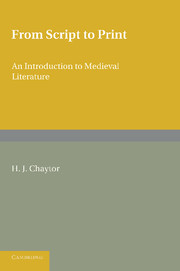Book contents
Chapter IV - Style and Criticism
Published online by Cambridge University Press: 05 June 2016
Summary
WHEN a vernacular has become sufficiently stabilised and widespread to produce literature, questions of style begin to arise: What is the best mode of expression? How can expression be modified to suit a particular subject or to appeal to a particular audience? What means can be discovered for attracting and holding attention or for securing applause? These were matters that had been discussed and analysed by rhetoricians long before medieval times, and many a medieval writer was brought up under their precepts. But before entering upon this subject, it is necessary to know in what sense the term ‘style’ is now generally used.
Obviously, the nature of the subject-matter and the character of the reader or audience must often dictate the character of the language used; to rewrite a proposition of Euclid in the manner of Gibbon or Carlyle would be to produce a result not only grotesque, but useless for its purpose; nor does a man of sense talk to his family as he would address a political meeting. If the appeal is made to intellect, the manner will not be that of an appeal to emotion. Methodical Germany recognises a Schriftsprache and an Umgangssprache, which latter may be divided into a Vortragssprache, a Verkehrssprache and a Familknsprache, the respective manners of oratory, of official intercourse and of conversation. Schriftsprache, the literary language, will include variations dependent upon subject-matter, and in every language which has reached the stage of nationality, these differences will be apparent in greater or less degree. The ancient rhetoricians were familiar with them and laid down rules for the teaching of them; these were elaborated in medieval times and were known as arts of style. Oratory and poetry had their appropriate styles, and careful analysis of the most famous poems and speeches had evolved a body of rules and precepts, the observance of which was thought essential for success.
Thus we speak of a conversational or of an oratorical style with reference to the particular manner of delivery and choice of words which the occasion may demand. So medieval critics regarded style as a manner which could be changed at will, the change being determined by the nature of the subject with which the artist had to deal; even as a man invited to a party will change his working clothes for a more formal dress.
- Type
- Chapter
- Information
- From Script to PrintAn Introduction to Medieval Literature, pp. 48 - 82Publisher: Cambridge University PressPrint publication year: 2013



